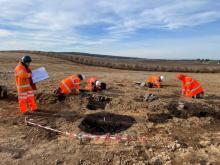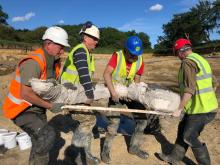
Overburden stripping is part of any quarry operation but on some sites this work turns up some interesting artefacts that significantly add to historical knowledge
Often the potential to find archaeological artefacts on a site is known well before any topsoil is stripped from a quarry but sometimes what is unearthed is far more important than anyone could guess. The sheer size of quarries means that the overburden management has the potential to provide a huge window onto previous use of the landscape and significantly advance archaeological understanding.
Recent work at
"The age and location of this find suggests that its construction was not as a result of Roman influence," said Tim Malim, who directed the SLR archaeology team. "It could well indicate that Iron Age Britons were sophisticated road engineers in their own right and had developed the technological expertise to build sophisticated all-weather roadways for wheeled traffic. The road is more than 1.5m high and 6m wide, constructed in three distinct phases and surfaced with imported river cobbles." Tarmac estates manager Malcolm Lawer said, "This is an exciting discovery which we understand may change the accepted view that the Romans built the earliest roads in Britain." So far 400m of road have been unearthed and it is thought it may have connected the capital of the Cornovian tribe at the Wrekin with the Old Oswestry hill fort near Oswestry. Archaeologists have discovered evidence of animal dung and dung beetles indicating that prior to construction of the road it had been used in more ancient times as a livestock droveway.
This is just one example of the way quarrying has helped to further historical knowledge.
"Archaeological investigation is an important step in any new development or expansion of an existing quarry and is usually a legal requirement of the planning application process in the UK," explained Lawer. "Most of the time we already know that there is a high possibility of archaeology at a new site either from existing records that are recorded in the environmental statement for the site or from trial pitting or geophysical surveys. These types of investigation are common but it is not done on every site." Quarrying is a major funder of archaeological investigation. "The
"House building and infrastructure projects are also major funders of the sector.
"Quarrying has contributed a lot to archaeology but there is one site that sticks out in my mind as significant - Tarmac's Clifton Quarry in Worcestershire underwent several phases of investigation work as the quarry progressed and resulted in some important Neolithic finds including six polished axes, pottery and flints. The settlement dates back to when cereals were first being farmed in the British Isles and over 9000 grains of barley were found at the site, which demonstrates the scale the farming had reached." According to Jackson, the UK planning system allows for a watching brief that permits archaeologists to see vast tracts of land during the overburden strip of quarries. "Housing developments allow you to see a small part of history but quarries show the whole story in terms of actual finds, landscape features and building environmental knowledge," he said.
Nonetheless, Malim believes that there is often some concern from the quarrying sector that operators are being asked to do too much and requested to repeat the same type of investigation in similar deposits again and again. "The latest guidance in the UK does try to address proportionality in terms of significance but quarrying is totally destructive when it comes to archaeology so it is important and does add to knowledge," he said.
"Sometimes that knowledge means that something that was once thought to be rare is actually proved to be more common based on the number of finds but there is also the chance that stripping the overburden for a new quarry will unearth something new or particularly well preserved." According to Andrew Josephs, who is managing director of Andrew Josephs Consulting, without quarrying this history would have remained hidden and would then maybe have eventually been destroyed by the plough if the land was used for agriculture. "Archaeological digs are destructive but it allows the evidence to be recorded," he said. "Quarrying is also destructive in its way but gives access to the archaeology.
"In the UK there has been a significant increase in knowledge since 1990 when new planning laws came into force, which does raise the question of how much was lost before the new planning legislation?" Malim added that quarries have been the location of some very significant finds including a Saxon helmet found on a Pioneer (now part of Hanson) site near Woolthorpe.
Although Josephs' main experience is in the UK, he said that not all other countries in Europe have the same approach to archaeological investigation during overburden management processes. "In the UK, it is very much a case of 'polluter pays' whereas in other countries in Europe archaeological investigation is funded by industry levies or government funding," he said. "Some countries carry out very little archaeological investigation but the UK has always been a well populated country so is a rich area for archaeology. The situation is not the same all over Europe, which may explain the different approach." Malim added, "In the past many of the finds that were reported by the quarrying industry relied on interested operatives. In some situations it still does - Palaeolithic remains in gravels can be very difficult to record and monitor."







